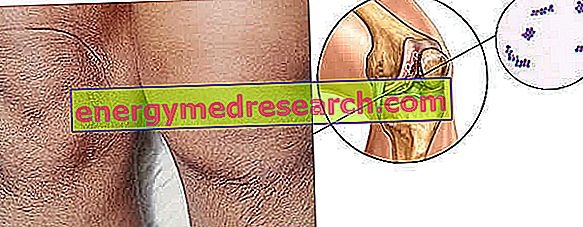Septic arthritis: definition
In medicine, septic arthritis designates a complex clinical picture, supported by a bacterial infection affecting a joint: to create similar damage, the pathogen, after having invaded the membrane and the synovial fluid, gives rise to an exaggerated inflammatory response, which can lead to the formation of the so-called piartro, a purulent exudate in the joint space.
Generally, when treated for time, septic arthritis responds well to therapy with antibiotics; however, the morbidity and mortality of the disease should not be neglected.

Incidence
Medical statistics show that, annually, septic arthritis appears in 2-10 cases per 100, 000 inhabitants; in the United States, for example, septic arthritis occurs in 7.8 subjects per 100, 000 healthy. Even in Europe the data is similar. With more precise parameters, streptococcal septic arthritis appears to affect 2.6 people per 100, 000, while disseminated gonococcal arthritis 2.8 subjects per 100, 000.
A percentage of patients estimated at around 25-50% suffers permanent damage, while 5-15% of patients, not subjecting themselves or not adequately responding to treatment, is destined to die.
Septic arthritis appears to constitute an increasingly imminent danger for the elderly, especially in conjunction with multiple diseases and immunosuppression.
An obstacle not to be overlooked is represented by the costs, often very high, for the hospitalization of the patient, for the application of prosthesis and for disability.
Causes
In spite of the fact that virtually every infectious agent can cause septic arthritis, in most cases bacteria are the main culprit. The penetration of bacteria is favored both by the absence of the basement membrane, and by the high vascularization of the synovium: pathogens reach the site of action by haematogenous route. Although any joint can be affected by the infection, therefore developing septic arthritis, the most involved sites are hip, knee and shoulder.
It often happens that pathogens, after reaching the blood, reach the joints and invade the synovial membrane; subsequently they are phagocytosed by inflammation mediators and fibroblasts. The necrosis and swelling of the synovial membrane and the cartilage that ensue are an expression of the massive release of proteolytic enzymes and the accumulation of purulent synovial fluid.
In some cases, septic arthritis is a complication of arthroplasty (incidence rate: 1-15%); in others, on the other hand, infection occurs after the direct inoculation of pathogens (eg administration of intra-articular medications, arthrocentesis, joint operations).
How can septic arthritis occur?
- For direct inoculation, following intra-articular injections
- Haematogenous, typical of drug addicts, patients subjected to catheterization and suffering from endocarditis
- For haematogenous spread from a distant focus (similar to osteomyelitis)
Risk factors
Some subjects are more at risk of septic arthritis, probably due to advanced age or the presence of degenerative pathologies. The most common predisposing factors are summarized below:
- AIDS
- Arthrosis
- Catheterization
- Systemic connectivitis: rheumatoid arthritis, systemic lupus erythematosus, gout
- Haemophilia
- Diabetes mellitus
- Bacterial endocarditis
- Infant age (less than 3 years) or advanced (over 80 years)
- Implantation of prostheses
- Long-term administration of steroids and immunosuppressants
- Drug addiction: the promiscuous use of non-sterile syringes can promote infection
Resistance to antibiotics is also a real and particularly acute problem: some pathogens seem to resist even a heavy antibiotic therapy.
Microorganisms involved
The vast majority of septic arthritis is triggered by infections sustained by Staphylococcus aureus ; however, streptococci are also often involved etiopathological elements. Gonococcus ( Nesseria gonorrhoeae ) is the pathogen most often responsible for septic arthritis in sexually active adults. The bacterium Haemophilus influenzae seems, instead, to be the gram negative bacterium responsible for most of the acute septic arthritis in the child (2-3 years).
More rare, albeit possible, are septic arthritis mediated by HIV, Mycobacterium tuberculosis (tuberculosis), Borrelia burgdorferi (protagonist of Lyme disease), Group A beta-hemolytic streptococcus, Pseudomonas aeruginosa, Aspergillus spp. and Candida spp ..
Clearly, vaccination (when possible) is an excellent defense weapon to protect against infections in general and septic arthritis in particular.
The table shows the pathogens most involved in the various forms of septic arthritis.
Type of septic arthritis | Involved microorganism |
Non-gonococcal septic arthritis | Staphylococcus aureus (> 70%), Streptococci olit hemolytic group B, C, G, Streptococcus pneumoniae, Borrelia burgdorferi, Brucella burgdorferi |
Septic gonococcal arthritis | Neisseria gonorrhoeae (<10%) |
Viral septic arthritis | HBV, HIV 1, Rubella, Parvovirus B19 |
Septic arthritis from mycobacteria | M. tuberculosis |
Fungal septic arthritis | C. albicans, S. schenckii, C. immitis |
Postinfectious septic arthritis | Shigella spp, Campylobacter spp, Salmonella spp, Yersinia spp, Chlamydia spp. |



